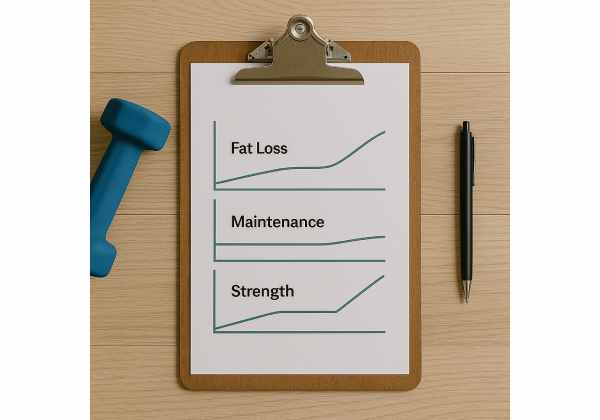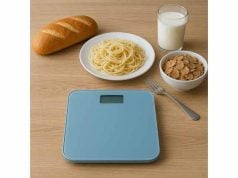
Progress rarely follows a straight line. The people who keep results year after year cycle their efforts on purpose: they plan short periods to lose fat, structured weeks to hold maintenance, and targeted blocks to build strength and muscle. This article shows you how to map those pieces across a calendar year without burnout. You will learn how long to stay in each phase, what to eat and track, and how to adjust when life gets loud. If you are currently stuck, bookmark our concise plateau troubleshooting guide and use it alongside this annual plan.
Table of Contents
- What an annual plan does
- How to periodize fat loss and strength
- Month by month template for 12 months
- Common mistakes and fixes
- Nutrition targets by phase
- Training priorities by phase
- How to evaluate progress and adjust
- Frequently Asked Questions
What an annual plan does
A good annual plan solves three problems most dieters never address: limited recovery, motivation fatigue, and drifting habits. By cycling between fat loss, maintenance, and strength blocks, you protect lean mass, keep enthusiasm high, and give yourself predictable windows to push or hold.
Why periodization works for real life
- Physiology: Fat loss requires a calorie deficit, but chronic deficits lower training performance and make muscle harder to maintain. Maintenance blocks stabilize hormones, replenish glycogen, and restore training quality so the next fat-loss phase works better.
- Psychology: Short, time-boxed cuts are easier to commit to, and maintenance phases give you a “practice season” for your future normal. Strength blocks keep you goal-focused without chasing a smaller scale number.
- Lifestyle: Life has seasons. Use high-demand periods (holidays, travel, exams, big projects) for maintenance, and save aggressive cuts for calmer months.
What a one-year map includes
- 2–3 fat-loss phases (4–12 weeks each) with clear start and stop dates.
- Equal or longer maintenance phases (4–12 weeks) after each cut.
- At least one dedicated strength block (8–16 weeks) focused on performance and muscle quality.
- Planned deloads (3–7 days) for training and, if needed, a brief diet break.
Progress goals per phase
- Fat loss: average 0.5–1.0% of body weight per week if you have more to lose; 0.25–0.75% if you are leaner. Keep strength stable.
- Maintenance: weight within a 1–2% range; skills and habits locked in; strong training.
- Strength: small, expected weight variance from food and glycogen; clear performance PRs or rep PRs.
Where to start if you are new
Confirm your intake and activity basics before mapping the year. If you need a fast refresher on energy balance, protein, and step targets, skim our weight loss basics to align your foundation.
Key takeaway: An annual plan turns random effort into momentum. You will cut less often, maintain more intentionally, and train with purpose—leading to better body composition and fewer stalls.
How to periodize fat loss and strength
Think of your year in quarters. Each quarter assigns a primary goal (fat loss, maintenance, or strength) and a supporting role (movement, recovery, or skill). You then adjust calories, macros, and training stress to match the priority.
Step 1: Pick goals by season
- Jan–Mar: Many prefer a focused fat-loss block when routines feel structured.
- Apr–Jun: Transition to maintenance to practice social eating and stabilize.
- Jul–Sep: Emphasize strength and muscle while enjoying summer flexibility.
- Oct–Dec: Choose a short cut or maintenance through holidays, then reset.
Step 2: Set time boxes
- Fat loss: 6–10 weeks works for most. If you have a larger target, stack two cuts with a maintenance phase between them instead of one long grind.
- Maintenance: 6–12 weeks minimum. The point is not to hover; it is to live at maintenance on purpose.
- Strength: 8–16 weeks. Progress is slower than cutting on the scale but faster in the gym—treat it like a true training cycle.
Step 3: Align nutrition with the block
- Fat loss calories: 15–25% below current maintenance.
- Maintenance calories: at or near true maintenance (you should be able to eat out, train hard, and sleep well without scale creep).
- Strength calories: maintenance to +5% surplus if you are comfortable with a slight gain, especially if you are newer to lifting.
If you wonder how long you should stay in a deficit at one time, review the signals in our guide on deficit length to avoid overshooting your recovery.
Step 4: Program training to match
- Fat loss blocks: 2–4 strength sessions per week; lower volume than strength blocks but focused on big lifts, high effort, and keeping reps or load steady. Add brisk walking and short conditioning.
- Maintenance blocks: increase volume toward your sweet spot; progress reps and technical skill.
- Strength blocks: emphasize progressive overload (sets × reps × load), skill practice, and rep PRs; use cardio for health and recovery without stealing from lifting.
Step 5: Build recovery in
- Deloads: every 4–8 weeks, reduce sets by ~30–50% for one week.
- Diet breaks: during longer cuts, 7–14 days at calculated maintenance can steady mood and training.
Key takeaway: Choose the block, set dates, match food and training to the goal, and protect recovery. That is periodization in practice.
Month by month template for 12 months
Use this as a blueprint and shift months to fit your calendar. Keep the intent intact: push, hold, or build—never all three at once.
January (Weeks 1–4): Fat loss
- Calories: ~20% below maintenance; protein 0.7–1.0 g per lb goal body weight.
- Training: 3 full-body strength days; 6–9k steps; 1–2 short cardio sessions.
- Focus: food logging accuracy and bedtime consistency.
February (Weeks 5–8): Fat loss
- Keep calories and protein constant; consider one diet break weekend if social events demand it.
- Training: same structure; edge one lift up each week (1–2 reps or 2–5 lb).
- End-of-month check: average weekly loss still 0.5–1.0%? If not, tighten logging or reduce 100–150 calories.
March (Weeks 9–12): Maintenance
- Calories: raise to calculated maintenance; keep protein steady.
- Training: add one accessory set per big movement; push rep PRs.
- Lifestyle: practice eating out once weekly without scale creep.
- If you are not sure where maintenance sits, learn the simple method to find it in maintenance calories.
April (Weeks 13–16): Maintenance
- Keep weight within a 1–2% range.
- Add a hobby cardio day (hike, cycle) for enjoyment.
- Bedtime goals: 7–9 hours, phone out of the room.
May (Weeks 17–20): Strength
- Calories: maintenance to +3%.
- Training: 4 days per week; add a dedicated lower-body day.
- Progress mark: add a set on your main lifts or increase average load by ~2.5–5%.
June (Weeks 21–24): Strength
- Keep steps up for recovery; keep cardio easy.
- Food: 80–90% at-home meals on weekdays; flexible weekends with guardrails.
- Mid-block deload: one lighter week to consolidate gains.
July (Weeks 25–28): Maintenance
- Travel? Hold maintenance, eat protein at each meal, and prioritize steps.
- Training: minimum effective dose—2 full-body lifts, one short circuit, daily walks.
August (Weeks 29–32): Short fat-loss pulse
- 4–6 weeks at ~15–20% deficit if energy and schedule allow.
- Keep training to 3 days, high effort, low fluff.
- Expect faster visual changes from earlier strength work.
September (Weeks 33–36): Maintenance
- Rebuild calories; keep protein high.
- Return to normal training volume and technique work.
October (Weeks 37–40): Strength or maintenance
- Choose based on goals and holidays. If strength: push progressive overload. If maintenance: refine habits for party season.
November (Weeks 41–44): Maintenance
- Plan social events in advance; one indulgent meal is not a bad week.
- Weekly “guardrail weigh-in” to spot drift early.
December (Weeks 45–52): Maintenance with micro-cycles
- 2-week micro-block: light strength + walks before travel.
- 1-week deload around holidays.
- Last week: map January’s cut, update training templates, stock the pantry.
Key adjustments through the year
- If strength stalls during a cut: reduce volume and protect top sets; add sleep.
- If weight drifts at maintenance: re-estimate intake by tracking three typical days.
- If training enthusiasm dips: swap one gym day for a fun activity and leave one rep in the tank on main lifts.
Key takeaway: Your calendar becomes a coach. Each month has a job, and you repeat the cycle—leaner, stronger, more consistent—every year.
Common mistakes and fixes
Even good plans fail for familiar reasons. Spot them early and apply the fix the same week.
Mistake 1: Cutting too long
Extended deficits flatten training and mood. Fix: limit cuts to 6–10 weeks and earn the next cut with a full maintenance phase. If you are unsure whether to keep dieting, work through the signals in our plateau checklist before slashing more calories.
Mistake 2: Treating maintenance like a pause button
People stop tracking, stop training, and call it “maintenance.” Fix: keep anchors—protein targets, 2–4 strength sessions, step goal, weekly weigh-ins, and a simple meal structure.
Mistake 3: Chasing PRs deep into a cut
Aggressive volume while dieting burns you out. Fix: prioritize intensity over volume, keep two compound lifts per session, and deload on schedule.
Mistake 4: No deloads
You cannot add stress forever. Fix: every 4–8 weeks, cut set volume by ~30–50% while keeping movement patterns.
Mistake 5: Data without decisions
People collect numbers but do not act. Fix: set thresholds:
- If weight and waist are flat for 3–4 weeks in a cut → reduce 100–150 calories or increase steps by 1,500/day.
- If weight rises >2% at maintenance for two weeks → track intake and re-confirm maintenance.
Mistake 6: All-or-nothing holidays
One party turns into a lost month. Fix: hold maintenance, plan indulgences, and hit your non-negotiables: protein, steps, bedtime.
Mistake 7: Ignoring stress and sleep
Recovery drives adaptation. Fix: protect a consistent bedtime and add a 10–15 minute wind-down. Prioritize calm cardio (walks, easy cycling) when stress spikes.
Key takeaway: Most stalls are behavioral, not metabolic. Small, timely corrections keep the year on track.
Nutrition targets by phase
Match your calories and macros to the phase so training and recovery support your goal.
Calories
- Fat loss: start 15–25% below maintenance. Smaller, leaner individuals do better with the low end.
- Maintenance: calculated maintenance ±2%. Expect minor day-to-day swings from sodium and glycogen.
- Strength: maintenance to +5% if you are okay with a small, managed gain.
Protein
- All phases: 0.7–1.0 g per lb of goal body weight. Higher ends help satiety in a cut and lean mass during strength blocks.
Carbohydrates
- Fat loss: allocate remaining calories with carbs supporting training days (e.g., higher carb on lift days, lower on rest).
- Maintenance and strength: more room for carbs to fuel volume and recovery.
Fats
- Baselines: do not drop below ~0.3 g per lb body weight for most adults.
- In strength blocks, moderate-high fats help calorie density if appetite is low.
Meal timing and structure
- Fat loss: anchor each meal with 25–40 g protein; front-load vegetables; place most carbs around training.
- Maintenance: practice flexible meals out; keep protein steady; use a simple plate method at restaurants.
- Strength: pre-workout snack with protein + easily digested carbs; post-workout protein within a few hours.
If you want a deeper walkthrough of macro setup for the “hold” phase, see our overview of maintenance macros to stay satisfied without drift.
Supplements (optional)
- Foundations: creatine monohydrate, vitamin D if deficient, caffeine as needed.
- Electrolytes: helpful for high-sweat training or hot climates.
- Protein powders: a convenience tool, not a requirement.
Hydration and sodium
- Keep daily fluids consistent. If the scale spikes after salty meals, note it and watch the weekly average.
Key takeaway: Keep protein high across the year; move calories and carbs to match the work. Simple changes beat complicated rules.
Training priorities by phase
Your gym work should change with the goal instead of staying static all year.
Fat loss blocks: keep strength, reduce volume
- Frequency: 2–4 lifting days.
- Structure: full-body or upper/lower.
- Volume: moderate; keep 2–3 hard sets per movement, 1–3 reps in reserve on most sets.
- Conditioning: brisk walking, short intervals once or twice weekly.
- Goal: maintain loads and technique; do not chase high fatigue.
Maintenance blocks: build skill and capacity
- Frequency: 3–5 lifting days depending on time.
- Volume: add one set to key movements; pursue rep PRs.
- Conditioning: steady-state for health and recovery.
- Skill: clean up range of motion and tempo; sprinkle in unilateral work.
Strength blocks: progressive overload with purpose
- Frequency: 3–4 days with a main lift focus (squat, hinge, press, pull).
- Progression: linear or undulating (e.g., heavy, power, volume).
- Accessory work: targeted hypertrophy on weak links.
- Conditioning: minimum effective dose so legs and back stay fresh.
Non-exercise activity (NEAT)
Steps are the secret thread through all phases; they boost calorie burn, sleep, and appetite control. If your step count drops when dieting, you will lose slower even at the same calories. For ways to keep daily movement high, review practical ideas in daily movement.
Deloads and autoregulation
- Plan deloads but also adjust within weeks. If bar speed slows, sleep is poor, or joints ache, trim a set, shorten the session, and walk more.
Key takeaway: Train for the phase you are in. Maintain strength while cutting, practice and progress at maintenance, and push overload during strength blocks.
How to evaluate progress and adjust
A plan is only as good as your feedback loop. Use simple metrics, decide on thresholds in advance, and make changes on schedule—not out of frustration.
What to measure
- Scale trend: daily weigh-ins under identical conditions; review the 7-day average.
- Waist circumference: at the navel, once weekly upon waking.
- Performance: top-set load or reps on key lifts; rep PRs count.
- Photos or clothes: monthly in consistent light, or use a “test outfit.”
- Behavior anchors: steps, bedtimes, training sessions completed.
Decision thresholds by phase
- Fat loss: if the 7-day average and waist are flat for 3–4 weeks, first check logging accuracy and step count; then adjust calories by ~100–150 or add 1,500 steps/day. If training craters, shorten the cut or move to maintenance.
- Maintenance: if weight drifts >2% for two weeks, track intake for three normal days and recalc maintenance. If training improves and weight is stable, stay the course.
- Strength: if lifts and reps stagnate for 2–3 weeks, consider a deload, a small calorie bump, or narrowing exercise selection.
When to swap phases
- From cut to maintenance: when fatigue climbs, training slides, or life gets busier. Better to cut shorter and repeat later than grind and quit.
- From maintenance to cut: when habits feel automatic, sleep is strong, and you want to sharpen the look.
- From strength to maintenance: when joints feel beat up or you have a travel-heavy month.
Weekly review ritual (20 minutes)
- Check scale average, waist, and three training highlights.
- Note two behavior wins and one friction point.
- Decide on one small change for the next week (e.g., earlier lights-out, extra 1,000 steps on rest days).
- Confirm whether you are staying in the phase or switching on a specific date.
Key takeaway: Let data and dates drive your decisions. Small, pre-planned adjustments keep momentum without yo-yoing.
Frequently Asked Questions
How long should each fat-loss phase last?
Most people do best with 6–10 weeks of focused dieting before returning to maintenance. Shorter cuts preserve training quality and motivation. If you have more to lose, repeat cycles across the year instead of one long deficit.
How many maintenance weeks do I need between cuts?
Plan 6–12 weeks at maintenance between fat-loss phases. Use that time to normalize hunger, restore training volume, and practice flexible eating. Maintenance is not “doing nothing”—it is where you build the habits that keep results.
Can I build muscle while losing fat?
You can, especially if you are newer to lifting or returning from a layoff. Still, progress is slower. Reserve your biggest strength gains for maintenance or slight surplus phases. During a cut, aim to maintain strength and protect muscle.
What should my calories be during a strength block?
Start at maintenance and increase up to 5% if performance or training volume stalls and you are comfortable with a small, controlled gain. Keep protein high and distribute carbs around training for better sessions and recovery.
How do I handle holidays without losing progress?
Hold maintenance through busy weeks. Keep non-negotiables: protein at each meal, daily steps, and consistent sleep. Plan indulgences, avoid all-or-nothing thinking, and return to normal structure at the next meal—do not try to “fix” a party with crash dieting.
When should I change phases if progress slows?
Use thresholds: in a cut, if the 7-day average and waist are flat for 3–4 weeks, adjust calories or steps. At maintenance, if weight rises >2% for two weeks, reassess intake. In strength blocks, deload or add a small calorie bump if lifts stall for 2–3 weeks.
References
- Resistance training prescription for muscle strength and hypertrophy in healthy adults: a systematic review and network meta-analysis 2023 (Systematic Review & Network Meta-analysis)
- Systematic review and meta‐analysis of protein intake to support muscle mass and function in healthy adults 2022 (Systematic Review & Meta-analysis)
- Protein Distribution and Muscle-Related Outcomes: Does the Evidence Support the Concept? 2020 (Systematic Review)
- A 1-week diet break improves muscle endurance during an intermittent dieting regime in adult athletes: A pre-specified secondary analysis of the ICECAP trial 2021 (RCT—secondary analysis)
- International Society of Sports Nutrition position stand: safety and efficacy of creatine supplementation in exercise, sport, and medicine 2017 (Position Stand/Guideline)
Disclaimer
This content shares general education on nutrition, training, and weight management. It is not medical advice and does not replace guidance from a qualified healthcare professional. If you have medical conditions, take prescription medications, are pregnant or breastfeeding, or have a history of disordered eating, consult your clinician before changing diet or exercise.
Share and follow
If this annual plan clarified your next steps, consider sharing it with someone mapping their year. For ongoing, practical tips, you are welcome to follow us on the platforms you prefer—Facebook, X, Instagram, or LinkedIn.










